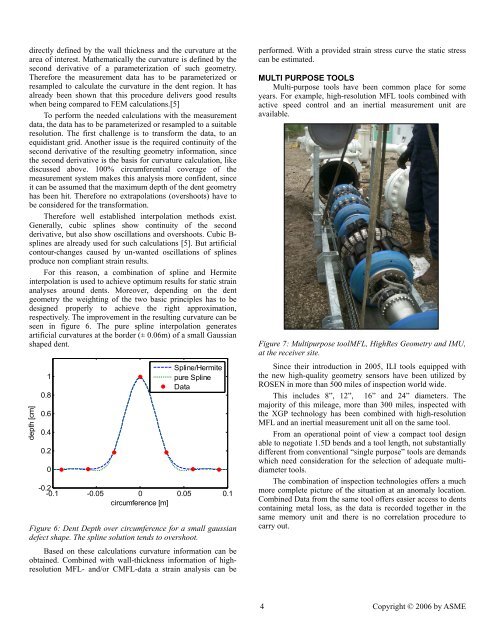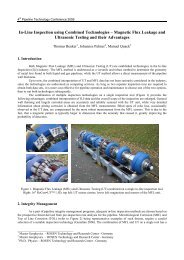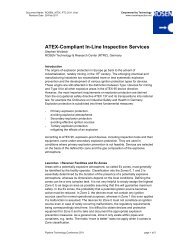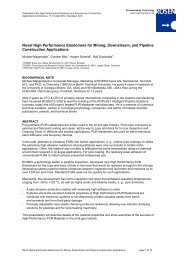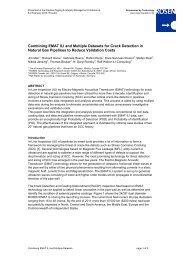View - ROSEN Inspection Technologies
View - ROSEN Inspection Technologies
View - ROSEN Inspection Technologies
Create successful ePaper yourself
Turn your PDF publications into a flip-book with our unique Google optimized e-Paper software.
directly defined by the wall thickness and the curvature at the<br />
area of interest. Mathematically the curvature is defined by the<br />
second derivative of a parameterization of such geometry.<br />
Therefore the measurement data has to be parameterized or<br />
resampled to calculate the curvature in the dent region. It has<br />
already been shown that this procedure delivers good results<br />
when being compared to FEM calculations.[5]<br />
To perform the needed calculations with the measurement<br />
data, the data has to be parameterized or resampled to a suitable<br />
resolution. The first challenge is to transform the data, to an<br />
equidistant grid. Another issue is the required continuity of the<br />
second derivative of the resulting geometry information, since<br />
the second derivative is the basis for curvature calculation, like<br />
discussed above. 100% circumferential coverage of the<br />
measurement system makes this analysis more confident, since<br />
it can be assumed that the maximum depth of the dent geometry<br />
has been hit. Therefore no extrapolations (overshoots) have to<br />
be considered for the transformation.<br />
Therefore well established interpolation methods exist.<br />
Generally, cubic splines show continuity of the second<br />
derivative, but also show oscillations and overshoots. Cubic Bsplines<br />
are already used for such calculations [5]. But artificial<br />
contour-changes caused by un-wanted oscillations of splines<br />
produce non compliant strain results.<br />
For this reason, a combination of spline and Hermite<br />
interpolation is used to achieve optimum results for static strain<br />
analyses around dents. Moreover, depending on the dent<br />
geometry the weighting of the two basic principles has to be<br />
designed properly to achieve the right approximation,<br />
respectively. The improvement in the resulting curvature can be<br />
seen in figure 6. The pure spline interpolation generates<br />
artificial curvatures at the border (± 0.06m) of a small Gaussian<br />
shaped dent.<br />
depth [cm]<br />
1<br />
0.8<br />
0.6<br />
0.4<br />
0.2<br />
0<br />
Spline/Hermite<br />
pure Spline<br />
Data<br />
-0.2<br />
-0.1 -0.05 0<br />
circumference [m]<br />
0.05 0.1<br />
Figure 6: Dent Depth over circumference for a small gaussian<br />
defect shape. The spline solution tends to overshoot.<br />
Based on these calculations curvature information can be<br />
obtained. Combined with wall-thickness information of highresolution<br />
MFL- and/or CMFL-data a strain analysis can be<br />
performed. With a provided strain stress curve the static stress<br />
can be estimated.<br />
MULTI PURPOSE TOOLS<br />
Multi-purpose tools have been common place for some<br />
years. For example, high-resolution MFL tools combined with<br />
active speed control and an inertial measurement unit are<br />
available.<br />
Figure 7: Multipurpose toolMFL, HighRes Geometry and IMU,<br />
at the receiver site.<br />
Since their introduction in 2005, ILI tools equipped with<br />
the new high-quality geometry sensors have been utilized by<br />
<strong>ROSEN</strong> in more than 500 miles of inspection world wide.<br />
This includes 8”, 12”, 16” and 24” diameters. The<br />
majority of this mileage, more than 300 miles, inspected with<br />
the XGP technology has been combined with high-resolution<br />
MFL and an inertial measurement unit all on the same tool.<br />
From an operational point of view a compact tool design<br />
able to negotiate 1.5D bends and a tool length, not substantially<br />
different from conventional “single purpose” tools are demands<br />
which need consideration for the selection of adequate multidiameter<br />
tools.<br />
The combination of inspection technologies offers a much<br />
more complete picture of the situation at an anomaly location.<br />
Combined Data from the same tool offers easier access to dents<br />
containing metal loss, as the data is recorded together in the<br />
same memory unit and there is no correlation procedure to<br />
carry out.<br />
4 Copyright © 2006 by ASME


